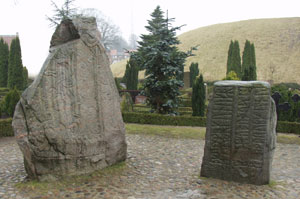Viking Runes
Although Viking legends and stories were largely passed down by song and memorized poetry, they did in fact possess a written language. Runes were used in various Germanic languages. The earliest runic inscriptions date from around 150 AD.
The two most significant Danish Viking variants are "Elder Futhark" (roughly 150-800 AD) and "Younger Futhark" (800-1100 AD) which are so named from the first six letters of their alphabet.
F U Þ A R K.
Each rune functioned as a letter that represented a sound that existed within the language at the time, however each rune was also an ideograph or pictograph that could represent some cosmological principle or power. Accordingly, runes had "magical" powers. Indeed the primary meaning of the Old Norse word "Rún" is a "mystery" or a "secret".
According to legend, the Norse god Odin speared himself to a tree, in a self-sacrificial attempt to receive sacred knowledge. At the end of his ‘shamanistic journey’, hanging suspended for nine windy nights, Odin learned the mysteries of the runes, which he then passed on to his people.
Since the Vikings believed the runic symbols to be a gift from Odin, they treated them with great reverence. Belief in the divine origin of the runes meant that runes possessed magical powers.
Words had great power in Viking society and recording an idea using a rune was a powerful act. As a result, we see runic inscriptions on Viking weapons as this afforded a transfer of magical power to the weapon.
Most Viking runes encountered in Denmark are Younger Futhark. The runic alphabet changed radically at the beginning of the Viking period..., changing from the complex 24 character Elder Futhark to the simplified 16 character Younger version.
Although the reason for the change is unclear, some researchers have suggested that the sounds and meanings associated with the elder version had become unclear as the language developed. The newer, simplified script may have been intended to insure that most people knew the sounds of the letters.
Viking culture was for the most part transmitted orally through song and poem, however this does not necessarily mean that Vikings were illiterate. Runes are a phonetic representation of a sound, so as long as one knows what sound is represented, you can read a Viking rune out loud even if you have no idea what the words mean. This means that anyone with knowledge of the sounds represented by the runes could sound out the words and was by definition "literate".
We see runes in common use for memorials or commemorations. It seems probable that many if not most Vikings could read the runic writing.
Because runes possessed magical power, it's reasonable to believe that this knowledge would be important. The Ynglinga saga tells us that:
"For men of consequence a mound should be raised to their memory, and for all other warriors who had been distinguished for manhood a standing stone, a custom that remained long after Odin’s time."
The most famous Runic stones in Denmark are the Jelling Stones which are located some 15 km north-west of Fredericia in central Jutland. They date from sometime in the mid 900's. Gorm died c. 958

LastUpdate: 2018-07-24 20:22:14
